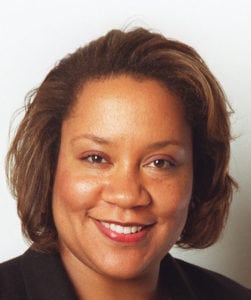 Dana Canedy is a force to be reckoned with.
Dana Canedy is a force to be reckoned with.
She is a Pulitzer Prize–winning journalist and the author of a book about to be made into a movie. She is the current administrator of the Pulitzer Prizes — the first African-American and first woman to ever hold the title.
Oh, and the youngest.
She wanted to be a writer since she was 12 years old. She grew up in a small town in Kentucky as an avid reader. “I read everything I could; I went to local public school. I didn’t have a lot of role models growing up. I lost myself in characters in books, historical figures — like Martin Luther King, Jr. and Toni Morrison,” she says.
She was the first on either side of her family to go to college, and it was in college that she discovered her calling as a journalist, where her passion for writing, for people and for asking “why” culminated in her current career.
After college, in 2000, while writing for The New York Times, Canedy was awarded a Pulitzer Prize for her piece, “Hurt Between The Lines,” part of a series on race relations. Canedy’s piece talks about race in the newsroom.
Now, 18 years later, she doesn’t see that much has improved as far as diversity in newsrooms. “I don’t think it’s better, I think it’s exactly the same, which is sad,” she says. “Journalism is in a bit of an existential crisis and diversity has become less of a priority. [Publications] are figuring out how to survive…things are stabilized, though there is still a lot of downsizing. We have to get back to a time where diversity is a top priority.”
It’s not just a social issue—it’s a matter of coverage. “Immigration is the biggest story going; you can’t cover that with an all-white staff,” she says.
Canedy says the best thing newsrooms can do is realize that it does not require a big budget to move the needle on diversity. It should be a multi-pronged, multi-year plan, and some of the options are absolutely free. “Give stretch assignments and opportunities,” she says. “Be more inclusive. Broaden who you think could be a department head and be more open to expanding what your leadership could look like.”
She cites internships as another great opportunity, but the commitment must come from the top and systems should be in place to keep the programs going.
In an interview with Columbia Journalism Review, Canedy said, “I am not a unicorn. There are so many women and people of color out there who can perform at high levels.”
Her advice to young journalists is to believe in yourself and to not take no for an answer. She faced people constantly questioning if she could do something, but she went out and did it.
“Barriers will knock you down,” she warns. “What motivated me was to prove to people who didn’t believe that I could do it. I said to myself, they seriously underestimated me, so get out of the way and watch.”
This does not mean her path to success was a straight line. She has faced obstacles, including the loss of her partner—the basis for her book, “A Journal for Jordan.” But she counts her biggest success in the number of people she has been able to mentor.
“That I can help in some way bring along the next leaders, has given me so much pleasure,” she says.
Still, having achieved much of what she wanted to do, she isn’t slowing down. At the end of the day, she’s a working mom who tries to do her best each day and provide a service for journalism.
She loves her new position with the Pulitzers (she has held the position since July 2017) and says she goes to work giggling. “I have not been this happy in years,” she says. “We have a lot of work to do, both to protect the integrity of what we do and what we’ve done so well for a century and modernize our brand at the same time.”
You can see some of what she’s been working on when the winners and nominated finalists are announced on April 16.
Photo credit: Naum Kazhdan/The New York Times
